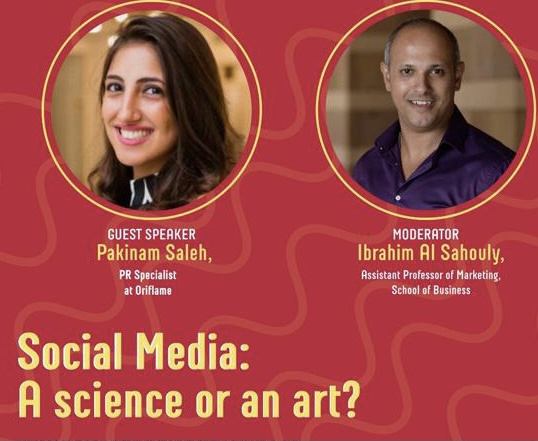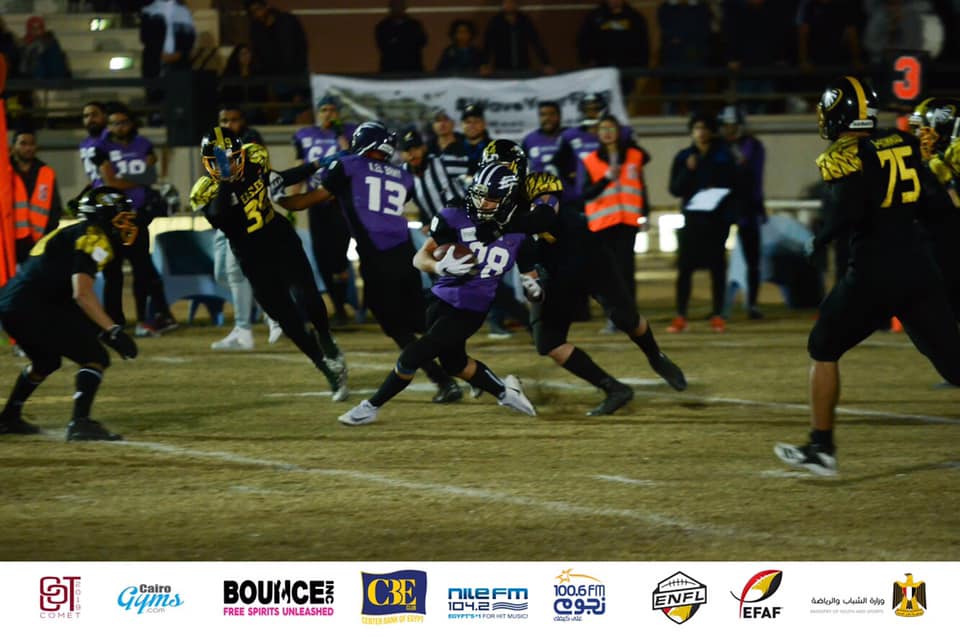The Art and Science of Social Media Marketing
By: Maya Abouelnasr
@EmEn1125
Public Relations Specialist Pakinam Saleh told an AUC audience last week that effective use of social media for marketing purposes first requires an understanding of its complex nature as both a science and an art.
The Zoom session, titled “Marketing Talk – Social Media: A Science or an Art?”, was moderated by Assistant Professor of Marketing in the School of Business Ibrahim Al-Sahouly.
While discussing the digital aspects of marketing, Saleh emphasized how traditional media is essential in the content creation process, as marketing rules and principles simply evolve to account for technological advancements but the core values and priorities are unchanged.
“You will never ignore the traditional [marketing approach] because it’s needed to have the full knowledge,” Saleh said.
She then described how social media is an art due to its creative aesthetics and design elements. It also serves as a platform for expressing creative ideas with the use of various stylistic techniques.
But as a science, social media requires research and analysis to ensure high engagement, reach, and an audience of organic followers – that is, followers who are not bought or brought in through sponsored ads.
One way some online marketers maintain an active presence on social media is through automation, which involves outsourcing campaigns and posts to web robots for auto-generating a repetitive style of content, as well as scheduling a constant flow of posts.
According to the Forbes’ Communication Council, a group of senior-level communications and public relations executives, this pattern and consistency in content can be effective if done properly but too much of it can be harmful as it can eventually bore people and cause errors.
For instance, in 2012, AT&T, an American telecommunications company, was giving away free tickets to the National Collegiate Athletic Association’s (NCAA) March Madness tournament.
Due to automation, several Twitter users ended up being targeted and tagged to “join the chase” for the tickets, with the tweets constantly going out every few minutes. It should be noted that many of those tagged users did not even follow AT&T, nor did their profiles indicate any interest in the NCAA or the March Madness event.
That is where the “scientific” analysis of insights and responses comes in. Saleh stressed that knowing what likes, shares, comments and views on certain posts all mean in relation to analyzing insights is crucial to gauging audience engagement and how to effectively react to that to avoid losses.
For example, if page viewers and engagements are stagnant or start to decrease with heavy automation in place, that could indicate to the company that they should seek to produce fresher content and engage more with their audience to keep their page exciting – or dynamic – for their audience.
Saleh elaborated by cautioning that the creation process on social media should not be about showing off the creators’ social media savviness. Rather, it is about having an impact on the audience in a simple manner to “prompt a call to action”.
Or, as American voice actor, musician, producer and writer Dave Willis says, “Don’t use social media to impress people; use it to impact people”.
Integrated Marketing Communication (IMC) Rawan Ibrahim considers analyzing insights and the amount of thought and work that goes into social media content creation to be crucial.
“I think that it [using social media to impact people] was the most important part [of the talk] and that it is a very convincing one for me. On social media, people can get amazed and impressed so easily, as the person or the product they see is behind a screen. They don’t see the real picture behind them [the product],” Ibrahim said.
Social media has become a major aspect in the teaching of all marketing courses, according to Marketing Professor in the department of Management Ibrahim Hegazy, who said that incorporating social media in marketing is a necessity and not a luxury as it used to be.
Hesham Dinana, an IMC professor in the department of Journalism and Mass Communication, reiterated the importance of employing social media and doing so effectively.
“It [social media] is about connecting [people]… to leverage this great opportunity of two-way communication in a meaningful way is very important,” Dinana told The Caravan.
He added that social media can at least increase awareness and generate buzz for products that are more-so about making an impression first, as opposed to making an impact first.
Dinana also said that understanding the customer before acting at all is especially crucial when considering today’s new age consumers who are more empowered and knowledgeable compared to past generations.
When asked whether Willis’ “impact, don’t impress” can apply to marketing impression-based durable goods, for instance, in the same way as consumer goods, Al-Sahouly said that the applicability of that idea in the case of marketing durable good differs, but an impact is still possible.
He then explained that social media is incorporated into around 80 percent of his course material. This percentage is even higher now, as students cannot be taken on field trips this semester. Instead, they have been asked to interact with companies on social media.




